 There has long been the thought by many Angelenos, especially those in the San Fernando Valley, that a smaller city is more efficient and can get things done more effectively.
There has long been the thought by many Angelenos, especially those in the San Fernando Valley, that a smaller city is more efficient and can get things done more effectively.The Daily News reports otherwise: The City of San Fernando, the tiny island of a municipality completely surrounded by the City Of Los Angeles in the Valley, can't seem to get its pool project off the ground. Dana Bartholomew reports it here.
It's an interesting issue, because the slow-paced rehabilitation of the earthquake-damaged Northridge Pool was an example of how a big city like LA needed to be broken up. It was a center-piece of the Secession movement in the Valley in 2001.
Well, smaller isn't always better, as the City of San Fernando exemplifies. Infighting among part-time councilmembers and "pet project politics" are just as prevalent in a city of 2.4 square miles and a population of 24,564 as with a city like Los Angeles with 465 square miles and a population of about 3.8 million.


4 comments:
Indeed, the inverse correlation between city size and government efficiency isn't nearly as strong as some might think. The Los Angeles DWP is a much stronger organization for the city's size, since it can bring market power to bear that compares to a private utility. Phoenix is quite large but is known for extraordinary efficiency in service provision. What matters more is fiscal capability--indirectly, a measure of the wealth of a city's residents. The cities that spend the most per resident on services are places like Beverly Hills and Manhattan Beach.
Smaller cities tend to optimize local service provision and fiscal capacity at the expense of the broader metropolitan area. It's great for the citizens of Cerritos or Culver City that their municipal governments are so good at attracting big-box retail, but the traffic spills over into neighboring cities.
I could go on about this for pages and pages because this is part of the core curriculum in my PhD program and I had to write about it on my screening exams, but I'll spare you guys.
Anecdotal evidence is all I have to offer, but in my experience, the smaller the city the more likely things are not being run in a fair and open way.
For every Culver City or Pasadena, there is a small city in Los Angeles County that has a crappy local government. Council members bought and sold bythe moneyed interests in the City, and staffers who haven't had a critical thought in 3 decades.
South-East L.A. is chock-full of crappy leadership and poorly coordinated services. I agree with L.A. City Nerd's thesis. Smaller is not always better.
Yeah, of course Glendale and WeHo are doing fine keeping their city services going smooth. But how about Maywood, Cudahy, Inglewood, Paramount, Huntington Park, Vernon, South Gate, Bellflower, Hawaiian Gardens, etc.?
There does seem to be an organic "optimal size" for each and every endeavor. City size is certainly one to be examined for "optimal sizing". The ability to support its people with its own natural resources is one issue. It's ecological footprint... Too large can be just as inefficient as too small. Even nature right-sizes itself when a population gets too large for its resources. Carolyn, SoCalNature.blogspot.com
Post a Comment